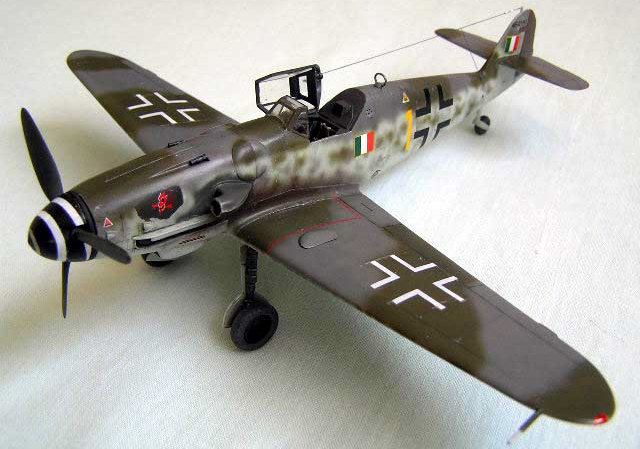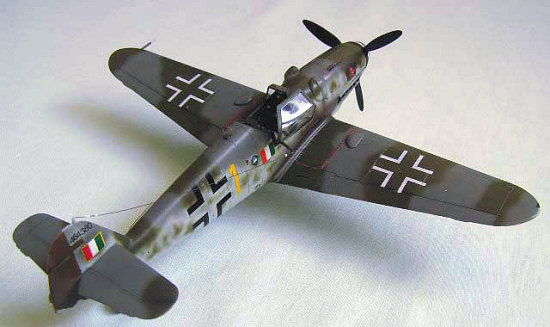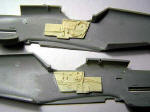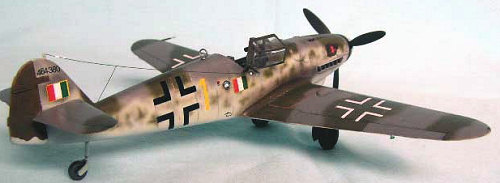
Academy 1/48 Bf-109G-14
| KIT #: | 1682 |
| PRICE: | $15.00 from Roll Models |
| DECALS: | See review |
| REVIEWER: | Fernando Rolandelli |
| NOTES: |

| HISTORY |
 Messerschmitt Bf 109G-14 W.Nr 464380, “Yellow 1”, 5ª Squadriglia, 2º Gr. C.,
Osoppo, March 1945
Messerschmitt Bf 109G-14 W.Nr 464380, “Yellow 1”, 5ª Squadriglia, 2º Gr. C.,
Osoppo, March 1945
This Gustav was flown by Magg. Mario Bellagambi, commander of 5ª Squadriglia. According to his own notebook, as described by D’Amico, 16 Gustavs, mostly G-14s, G-14/AS and possibly some G-10, were on strength in March, 1945. Bellagambi got “ace” status with 14 (11 with the ANR) victories, and survived the war. His mount almost did, being destroyed with a charge in the radio compartment at Villafranca, as “White 11” of 6ª Squadriglia, to which it had been transferred on 14th March.
This particular Gustav was unique in that the port fuselage flag had the fringes forward, and, above all, in that it has a Black fuselage “open-style” cross, the only known instance in which this occurs on a 109.
| THE KIT |
 This is
the Academy 109G-14 boxing of the old Hobbycraft kit. The tall tail is provided
as a separate insert, and the rear fuselage has to be cut to install it. The
wing is “hard”, having none of the numerous movable surfaces detached. Otherwise
it is a basic but good kit, may be rather bland in shape compared to the more
angular looking Hasegawa, but could be considered more accurate due to the extra
couple of millimeters in the nose area, which the latter sorely lacks. The
Academy boxing brings all the armament, tail wheel and wing bulge options, and
it even brings “Yellow 1” as the main version.
This is
the Academy 109G-14 boxing of the old Hobbycraft kit. The tall tail is provided
as a separate insert, and the rear fuselage has to be cut to install it. The
wing is “hard”, having none of the numerous movable surfaces detached. Otherwise
it is a basic but good kit, may be rather bland in shape compared to the more
angular looking Hasegawa, but could be considered more accurate due to the extra
couple of millimeters in the nose area, which the latter sorely lacks. The
Academy boxing brings all the armament, tail wheel and wing bulge options, and
it even brings “Yellow 1” as the main version.
| CONSTRUCTION |
Fuselage

 The
cockpit was customarily replaced by a True Details resin set; this is an easy,
inexpensive improvement which looks great (you should also have done it in any
Hasegawa 109). The cutting of the rear fuselage does not follow a panel line,
but if done with proper care, it gives absolutely no trouble. The troublesome
looking forward fuselage upper cowling follows the same rule.
The
cockpit was customarily replaced by a True Details resin set; this is an easy,
inexpensive improvement which looks great (you should also have done it in any
Hasegawa 109). The cutting of the rear fuselage does not follow a panel line,
but if done with proper care, it gives absolutely no trouble. The troublesome
looking forward fuselage upper cowling follows the same rule.
Some
things are better replaced: the carburetor intake by the spare one in every Hasegawa
109G-6/10/K; the
 guns
guns
 by the ones from the same source (I know, they are MG17s,
but they do not protrude enough to tell the difference and they are way better
anyway… deepen the gun troughs); if you had a spare tail wheel assembly and a
spare propeller it would help, I did not. The fairing over the battery was made
out of recycled resin. The main replacement I undertook was the windscreen: the
Academy one is difficult to extricate from the sprue without scratching it (your
best bet should be a saw) and, moreover, it has a frame almost in the middle of
the windscreen and is
by the ones from the same source (I know, they are MG17s,
but they do not protrude enough to tell the difference and they are way better
anyway… deepen the gun troughs); if you had a spare tail wheel assembly and a
spare propeller it would help, I did not. The fairing over the battery was made
out of recycled resin. The main replacement I undertook was the windscreen: the
Academy one is difficult to extricate from the sprue without scratching it (your
best bet should be a saw) and, moreover, it has a frame almost in the middle of
the windscreen and is
 too thin in the upper frames. I took the spare one found
in many Hase kits, and trimmed it to shape much as if it were a vacuformed one.
Someone achieved the same result by cutting the fuselage; this procedure, though
ruins the fuselage forever if something goes wrong, has the benefit of leaving
the fragile clear parts alone.
too thin in the upper frames. I took the spare one found
in many Hase kits, and trimmed it to shape much as if it were a vacuformed one.
Someone achieved the same result by cutting the fuselage; this procedure, though
ruins the fuselage forever if something goes wrong, has the benefit of leaving
the fragile clear parts alone.
Wings
 The main
work done here is inside the wells. The top wings had cutouts to accommodate the
larger tyres, that’s what the bulges are there for (the larger the tyres, the
larger the cutouts, the larger the bulges). I reproduced the effect by placing a
styrene sheet as a false upper wing. It works. I did not open the oval holes in
the leg recesses, nor detached any of the moving surfaces, just made sure that
the radiator flaps’ trailing edge did not melt or glue to each other. But period
pictures show 109s were parked with most of them lowered.
The main
work done here is inside the wells. The top wings had cutouts to accommodate the
larger tyres, that’s what the bulges are there for (the larger the tyres, the
larger the cutouts, the larger the bulges). I reproduced the effect by placing a
styrene sheet as a false upper wing. It works. I did not open the oval holes in
the leg recesses, nor detached any of the moving surfaces, just made sure that
the radiator flaps’ trailing edge did not melt or glue to each other. But period
pictures show 109s were parked with most of them lowered.
Mating everything
This was really effortless: I have seldom used as little putty as in this kit. The longitudinal “panel line” running through the entire rear fuselage, up and down, undoubtedly helped, but the upper wings to fuselage join did not need putty at all; the undersides just a reasonable quantity as did the upper cowl insert. Even the rear fuselage insert went on extremely well with just a bead of putty.
| COLORS & MARKINGS |
Painting
Well, the painting and decal instructions do really show some honest research. There are two versions:
1. - “Blue
2”, from 16./JG 53, flown by Gefr. Alfred Michel, during the infamous “Operation
Bodenplatte”. He was shot down at Waldweistroff on the way to its target, the
airfield at Metz-Frescaty. The young German pilot, on his first operational
mission, survived the subsequent crash landing and was taken prisoner by the
Americ ans. The
instructions for this airframe seem to be completely accurate, except maybe that
in the picture, the dark paint in the fuselage does not seem as solid as shown
in them.
ans. The
instructions for this airframe seem to be completely accurate, except maybe that
in the picture, the dark paint in the fuselage does not seem as solid as shown
in them.
2. - The real one, “Yellow 1”, Bellagambi’s plane. This is incorrectly presented as “785749” (as it is in the Skymodel sheet), which, according to D’Amico and Valentini, was a G-14/AS. Paint scheme is 74/75/76 with 81/82 rudder in the instructions, but 75/83/76 with 81/83 rudder according to the Italian authors (beware that by both “82” and “83” I mean the “darker” green). The flags are not well proportioned, but it is extremely difficult to find some which are, nor do they show the incorrect fringe on the forward edge. Nevertheless, as the fringe is separated from the flag, you can easily correct this. The Green on the flag is too light and the “Diavoli Rossi” emblem a tad too small. Otherwise, the decals correctly depict the open Black cross in the fuselage and the under wing ones lacking the usual White background.
I
followed the latter colour pattern, using WEMM paints throughout. For the RLM 81
I used French “Terre de Sienne”, as WEMM follows the “Olive Drab” variant of 81.
Beware that WEMM paints are not “toned down for scale-effect”, so you may wish
to do so. They otherwise spray quite good using Xtracolor thinner. I went for a
 heavy preshade, a light to non-existant postshade and some oils for weathering.
I painted mos of the scheme with a Paasche VL, except for the mottles, which I
painted with a VSR-90 (superb tool). I hid decal silvering with some chipping,
via a Silver pencil.
heavy preshade, a light to non-existant postshade and some oils for weathering.
I painted mos of the scheme with a Paasche VL, except for the mottles, which I
painted with a VSR-90 (superb tool). I hid decal silvering with some chipping,
via a Silver pencil.
Decals
Well, these were the chore of this model, and the source of the teaching every kit built leaves. In this case, it would read “never ever even start kits in which you have some expectations without top-notch decals”. I mean, not just good decals, but absolutely first rate. May be the real culprit was a non-too convincing gloss base. I started using a mix of the kit’s decals and the Skymodel sheet for the 109. Neither of them worked too well, with a slight edge for Academy’s. In the end, I mixed decals from a lot of sources, mainly old Aeromaster ANR sheets, and resorted to the numbers identifying the actual decals in the Skymodel sheet for the W.Nr. (of course, they are not the correct type, but at least the actual number is!) On behalf of Academy’s decals, the propeller spinner was taken from their sheet and it worked reasonably well with the customary trimming. No adverse effect was produced by the use of decal setting solutions.
| CONCLUSIONS |
Well, it is amazing that “there is no first-rate molding kit of the late 109G or K which is entirely correct”, but it is the pure truth. Hasegawa kits have the edge in detail and molding, and certainly look good, but lack that two mm in the nose. Of course, they are the only ones to offer the infamous “asymmetrical cowling”, so, if building a G-6 or -14/AS, a G-10 or a K, they are the kit of choice, unless you are prepared to some serious reshaping work. But regarding the “normal” G-6/-14 family, the Hobbycraft/Academy, with some replacements, modifications and decals, can be made into fine, reasonably accurate models.
| REFERENCES |
 -
“Camouflage and Markings of the ANR 1943-1945”,
D’Amico and Valentini, Classic Colours Publications.
-
“Camouflage and Markings of the ANR 1943-1945”,
D’Amico and Valentini, Classic Colours Publications.
- “German Aircraft Interiors. Part 1: Day Fighters”, Merrick, Monogram Publications
- “Jagdwaffe Volume 5 Section 3: Defending the Reich 1944-1945”, Robert Forsyth, Classic Colours Publications.
January 2007
Copyright ModelingMadness.com.
If you would like your product reviewed fairly and fairly quickly, please contact the editor or see other details in the Note to Contributors.